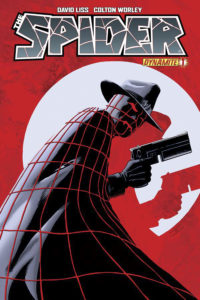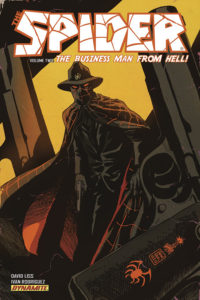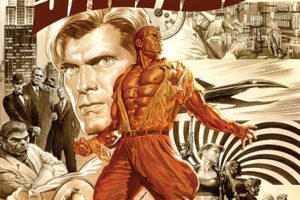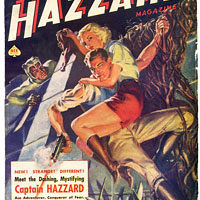 In 2012, Dynamite got the license for The Spider from Moonstone. They soon did a comic with The Spider, written by David Liss. But they moved the character into modern times and made various changes to all of the secondary characters. I, like many fans, wasn’t very pleased with what I saw. Hopefully you’ll see why.
In 2012, Dynamite got the license for The Spider from Moonstone. They soon did a comic with The Spider, written by David Liss. But they moved the character into modern times and made various changes to all of the secondary characters. I, like many fans, wasn’t very pleased with what I saw. Hopefully you’ll see why.
So, a brief recap of The Spider and his associates.
In the pulp, Richard Wentworth is a former Army major and wealthy playboy. It’s established that his parents are dead. He is accompanied in his adventures with several characers: his fiance, Nita Van Sloan; his Sikh manservant, Ram Singh; his butler, Jenkins; his chauffer, Jackson, who had served under him in the army; and Professor Brownlee, who provided him with weapons. He had to deal with his friend Commissioner Kirkpatrick, who figured that Wentworth may be The Spider, but couldn’t prove it.
Over the first few stories the outfit of The Spider evolved until he wore a fright mask, wig, and fangs, along with a hunchback, under a fedora and cloak. He also had the habit of stamping a spider logo on the foreheads of the criminals he killed.
In the comic, Wentworth is rich but works for the police as a consultant and was a veteran of the Iraq War (a captain). His father is still alive, and runs Wentworth Industries, which is in various lines of business, including making munitions. His father is also corrupt.
Ram Singh is his best friend and a lawyer who sometimes helps Wentworth; Jackson is his chauffeur (and served under him in the army, and well see below…). Jenkins is an employee of his father’s, a somewhat loyal aide to his father who comes on board The Spider’s “team.” Brownlee is a former employee of Wentworth Industries, now a professor at Columbia, younger than in the pulps, and is now black, and provides The Spider his weaponry, built on Wentworth tech. Wentworth’s outfit is more based on the outfit shown in The Spider movie serials: a full face mask and cloak/cape with a red spiderweb outline, along with high tech guns and other devices. He has a ring to brand his logo, but this is only used in the first storyline. And Nita is a reporter and editor of Times. And she’s married to Kirkpatrick! A new character is that of corrupt cop Detective Hilt, who is after The Spider.
One thing frustrating is how some characters change during the series. Jackson’s appearance and character changes between his first appearance and the next. Wentworth’s father’s appearance and character also changes after he’s in jail. The spider brand is used in the first storyline, then dropped and never mentioned.
Now, some of the villains are based on The Spider’s villains from the pulps, but not being up on them, I’m not sure how close they are to the originals.
The series ran 18 issues and an annual, all now collected in three trade paperbacks.
The first six issues had artwork by Colton Worley, which gave it an almost photo-realistic look. In the first five issues, The Spider is up against the Anput, the Zombie Queen. Hilt is involved with her. We get flashbacks of The Spider dealing with Cholera King, Silver Falcon, and The Terror, and with the Tarantula Terror. The corruption of Wentworth’s father is exposed and he is jailed, leaving Richard in charge of the company. The sixth issue has The Spider go up against the Wingman, and we are introduced to Jackson, but his appearance changes when he next appears and his problems in the army are forgotten. This storyline was collected in the first trade, Terror of the Zombie Queen, which includes all the variant covers as well as author’s notes on the first issues, where you see his intentional changes to the characters.
 The next six issues are collected in the second trade, The Businessman from Hell. We are introduced to Jenkins, whom Wentworth would like to get rid of, but who soon becomes part of his team. The Spider goes up against several new foes. He first deals with serial killer who paralyzes people and buries them so he can hear their pleas. He calls himself Lazarus. Then The Spider faces The Hater, who uses hypnosis to get his way, even making people kill themselves or others. And at the same time Wentworth is dealing with people trying to wipe out his company after his father’s imprisonment. After he deals with this, he faces The Fly, who is named after an original foe of The Spider. Here, he is an amoral schemer who became rich during the economic crash, and is not above killing people to get what he wants. He’s causing chaos and trying to take over New York, and doesn’t care who he kills. For some reason, Hilt takes on a costumed identity as The Lawgiver, and teams up with The Fly. And he’s as much a killer as The Fly.
The next six issues are collected in the second trade, The Businessman from Hell. We are introduced to Jenkins, whom Wentworth would like to get rid of, but who soon becomes part of his team. The Spider goes up against several new foes. He first deals with serial killer who paralyzes people and buries them so he can hear their pleas. He calls himself Lazarus. Then The Spider faces The Hater, who uses hypnosis to get his way, even making people kill themselves or others. And at the same time Wentworth is dealing with people trying to wipe out his company after his father’s imprisonment. After he deals with this, he faces The Fly, who is named after an original foe of The Spider. Here, he is an amoral schemer who became rich during the economic crash, and is not above killing people to get what he wants. He’s causing chaos and trying to take over New York, and doesn’t care who he kills. For some reason, Hilt takes on a costumed identity as The Lawgiver, and teams up with The Fly. And he’s as much a killer as The Fly.
But the storyline with The Fly and The Lawgiver wouldn’t be concluded until the next six issues that are reprinted, along with the annual, in the third collection, The City of Crime. The Fly makes use of an “iron man” suit (something from the original pulps), and The Spider goes up against him in his own suit. And The Fly engineers a takeover of Wentworth Industries, and puts one of his people (Norma) in charge. He is killed (as is Hilt), and Norma takes over, leaving Wentworth a fugitive. He must deal with a new foe, the Red Hand, who teams up with Norma and brings in some new costumed foes. The Spider takes down the Red Hand and gets rid of some of his new foes. But the last one, Gas Mask, teams up with Norma to terrorize the city and turn it against The Spider. But at the end of the series, Wentworth turns the tables on both of them and puts an end to both Wentworth Industries and The Spider.
The annual is a stand-alone story that sets up a possible new set of foes for The Spider to take out (which I suspect he came across in the war), but this is never closed out.
Certainly as a true version of The Spider, this isn’t it. There are things that are interesting, but bringing The Spider into modern times, and the updating and altering of the other characters is frustrating. But if you really want to check it out, the trades may be fairly easy to find.




It’s unfortunate, but there seems to be very little interest among readers making up today’s comic marketplace in reading period-set adventure characters. It’s the only explanation for why Dynamite continually tried to transpose characters whose original adventures took place in the 1930s and 40s into a present day setting.
Some other examples like The Shadow NOW and Doc Savage took the original characters and literally brought them into current times, while Kevin Smith’s Green Hornet established a connection between an older version (the original character) and a younger relative taking on the same identity in the present. Smith’s Green Hornet didn’t just have younger analogs of the original characters, but made a number of changes, and David Liss’ Spider (despite not having any legacy connection to an older character of the same name within the story) has vaguely the same feel to it as Smith’s update of the Hornet and Kato.
I guess you could say that this approach is similar to what Julius Schwartz did as editor of the Silver Age DC comics when he updated older characters like the Flash and Green Lantern, jettisoning most of the specifics while keeping the same character names and general concepts.
I would obviously prefer the more faithful approach of keeping the characters as they were in their original milieu, but that rarely seems to work commercially in today’s comic market.
I prefer the pulp characters remain in the time period that were created because, because I feel they best “work” there.
I can understand that some wish to either put the characters into a more modern setting, either a “blended world” (ie. Eclipse’s Spider series or DC’s First Wave) or our modern world. But I don’t care for that because too often they make alterations to the characters to try to make them “fit” into the modern world, which is what we see in series like Dynamite’s Black Bat or Spider (I haven’t read their Shadow NOW series). At least with Doc Savage they didn’t try to change the character in bringing him into the modern age.
I’d much rather that if creators want to do “pulp heroes in the modern world” that they instead create more original characters. Much like what was done in Incognito. Sure, they could do a “Shadow-like” character or a “Doc-like” character, but be original enough that we don’t get upset by the alterations.
I agree with you, Michael. Perhaps I just have a heightened perception of how much comic book fandom has changed since the 1970s when I personally entered into the picture. It might be a result of a lot of different outside influences (video games, the fractionating of popular characters like Batman or Spider-Man into a multiplicity of parallel counterparts, unfaithful media adaptations, and just a world where every medium is in a constant state of accelerated change, plus more recently the internet) and some internal marketplace influences as well (Marvel and DC’s once-revered continuity has suffered under constant revision-ing, and those companies don’t dominate the comic marketplace as solidly as in the past, and the number of new publishers and new titles is constantly growing, resulting in a reader base with no sense of a common history).
There just seems to be no real reverence for, or indeed even any interest in, the comic medium’s roots (whether that means Golden Age comics, or their newspaper adventure strip and pulp fiction antecedents) among today’s readers, even if that’s what a publisher would personally prefer to publish. Such titles are almost doomed from the start to commercial failure (despite whether or not they are quality titles) by the collective shrug given to these historical characters by the marketplace at large. Then there is the secondary problem entailed by the fact that there are not enough working professionals in the industry that have that love and reverence for the classic pulp characters. They all try to say nice things in promotional interviews about respecting “the classics”, but when direct questions are asked, they usually admit to little personal familiarity with the character. The exceptions to this rule, like Matt Wagner, seem to be exeedingly rare.
That’s the comic book market, of course. The reverence lives on only in the cottage industry of what is now professionally-published fan fiction (I speak here of Moonstone Books, Airship 27, Altus Press, et. al.). It’s a niche market and the numbers are small, too small to make a $4 color comic book distributed via the direct market commercially feasible. Moonstone seems to struggle with each comic release, never really gaining any ground in the market.